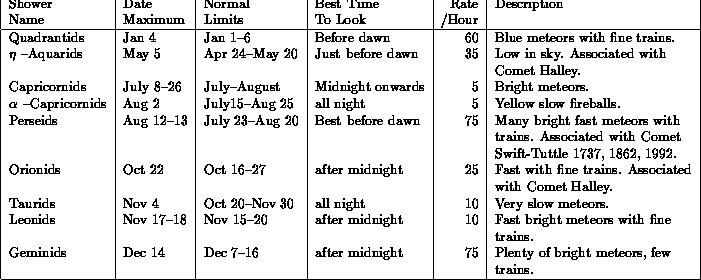
Previous: The Moon Up: The Solar System Next: The Perseid Meteors
Royal Greenwich Observatory
_________________________________________________________
Information Leaflet No. 34: 'Meteors and Meteorites'
'Shooting Stars':
All of us are familiar with the sight of a sudden flash of light passing across part of the night sky, possibly followed by a lasting streak of light. Although there are many aeroplanes and artificial satellites which can be seen, none of these look the same as a 'shooting star' or 'falling-star'.
Very occasionally the 'shooting-star' is very bright, brighter than the stars and it sometimes appears to emit sparks or even break up into pieces. On rare occasions its passage can be heard as a roar or a series of remote explosions. These very bright objects are often called fireballs.
The trail left by a bright 'shooting-star' may last for less than a second or, for a fireball, may last for minutes.
Meteors:
What we are witnessing when we see a shooting-star is a small piece of interplanetary matter, called a meteor, entering the Earth's atmosphere and 'burning up' at a height of about 100 km.
These small particles are moving very fast relative to the Earth and when they enter the Earth's atmosphere they are rapidly slowed down. This means that they lose a lot of energy, which appears as heat. Both the particle and the air that is forcing its way past are made very hot. The particle, unless it is large, is completely evaporated and the air in the path of the meteor is ionised. We see light from the emission of radiation from the ionised gas and from the white-hot evaporating particle. The trail is the hot gas gradually cooling down.
The astronauts, when they re-enter the Earth's atmosphere, have to take severe precautions to orient their spacecraft correctly so that the shielding which is designed to absorb and dissipate the heat caused by the impact with the atmosphere can do its work. If, for some reason, the shields did not work, the astronauts would suffer the same fate as a meteor!
Meteorites:
When large chunks of the interplanetary matter enter the atmosphere it is unlikely that all of the chunk will be evaporated. The outer layers will disappear but the centre is likely to survive and will hit the ground. The object that hits the ground is called a meteorite. The speed with which small meteorites hit the ground can be around 500 km/h.
More than 2,000 meteorites have been recovered. They are of different types,
Stony meteorites, iron meteorites and the rare carbonaceous chondrites.
The largest meteorite that has been found is the 60 tonne Hoba iron
meteorite; the largest stony meteorite weighs about a tonne and the Allende
carbonaceous chondrite was a series of chunks that totalled about 5 tonnes.
Impact craters are known on the Earth that correspond to bodies far larger than these. One of the best known is the Arizona crater in the USA, which is 1,280 metres across and 180 metres deep. It was formed several thousand years ago by a 250,000 tonne meteorite with a diameter of 70 metres hitting the Earth at a speed of nearly 60,000 km/h.
Meteor Showers:
Many meteors originated in material stripped off from comets by radiation
from the Sun. This material continues to follow the orbit of the originating
comet but gets spread out along the orbit. If the path of the Earth passes
through this stream of particles then we will see many meteors whose paths
in the sky will appear to radiate from one point in the sky (the radiant)
which is in the direction from which the stream is coming. Many such meteor
showers are seen throughout the year. Some are associated with known comets
while others are remnants of comets that are unknown. Most showers produce
about 20, or so, meteors per hour, but there are showers which can produce
thousands of meteors over a period of less than an hour. Such shows are,
unfortunately, very rare.
Meteor showers are named after the constellation from which they appear to
radiate. A list of prominent showers is given below.
Sporadic Meteors:
Meteors may be seen on any night of the year when the Moon is not bright. If
no prominent shower is active then most of the meteors that are seen will
come from random directions in space and will thus show no tendency to
radiate from any part of the sky. These meteors are called sporadic meteors
and about 7 per hour is the normal rate for them to be seen. Most fireballs
and meteorites are sporadic meteors. The material in these meteors is
associated with the material in the asteroids and it is likely that they
represent material that has come from fragmented asteroids.
Some rarer types of meteoric matter are believed to have originated on the
Moon and on Mars, probably as a result of matter being exploded from the
surface by the impact of a large meteorite.
Meteor Showers:

Dates given above may vary slightly from year to year. Some showers give much better shows every few years. The presence of a bright moon will severely reduce the chances of seeing meteors.
See also the Leaflets on individual meteor showers, the Perseids and the Leonids.
Produced by the Information Services Department of the Royal Greenwich Observatory.
PJA Wed May 8 10:44:36 GMT 1996
webman@mail.ast.cam.ac.uk
![]() Updated: May 13 '97, June 24 '14
Updated: May 13 '97, June 24 '14
Best seen with Font Verdana.
See About the Web Pages of Observatorio ARVAL.
For some illustrative images and excellent texts, link to:
Meteoroids and Meteorites
in Calvin J. Hamilton's Views of the Solar System
Back: ARVAL - RGO Leaflets - The Solar System
Messages: